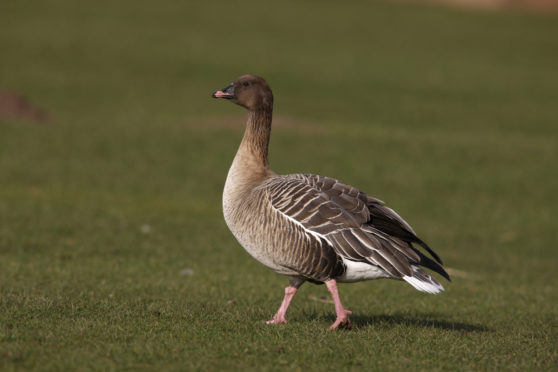It was a case of summer meets winter; skeins of honking pink-footed geese high in the sky above Loch Leven, but wildflowers still in bloom down by the track edge, with bees, hoverflies and other insects eagerly gorging themselves upon the late-season nectar.
But these knapweed, Devil’s-bit scabious and viper’s-bugloss flowers were well past their best, and as the geese flew overhead, one could sense that real change was in the air, with nature being on the cusp of a new season of cold temperatures and long dark nights.
I wandered down to one of the bird hides overlooking an area of wetland by the RSPB visitor centre. Out on the water several tufted ducks roll-dived in search of invertebrates and water plants, while a pair of nervous moorhens glided across a pool. The main influx of winter wildfowl had yet to arrive, but despite this, large rafts of ducks bobbed about on the main loch – mainly tufties and mallards, but also a few pochards.
Another v-shaped flock of pink-footed geese spiralled above me, the air ringing with their high-pitched metallic calls. I wondered whether these birds had come from Iceland or Greenland, and whether their migration had gone smoothly, or had they endured storms and difficult flying conditions.
In global terms, Scotland is hugely important for northern geese populations, holding 50% of the world’s wintering pink-footed geese, 60% of Greenland greater white-fronted geese and 20% of barnacle geese. Over 95% of the Icelandic greylag population winters here.
Our unique geographical location on the edge of the north-east Atlantic, with relatively mild weather and rich feeding on the coast and in fields makes us the perfect winter destination for Arctic geese. This underlines why conservation needs to be international and all-encompassing, carried out on an integrated basis with other countries so that breeding habitats, along with migratory stopover points and wintering grounds are properly protected.
I made my way back from the wetland area and headed towards Levenmouth in the south-east corner of the loch where a large congregation of mute swans had gathered. I scanned the flock to see if there were any whooper swans in among them. I failed to spot any, but they will be here any day now, swooping in from their Icelandic breeding grounds. At peak times, Loch Leven can host up to 10% of Scotland’s wintering population of whoopers.
I moved out onto a small sandy beach and stood for a while, breathing in the scenery and listening to the calls of the wild. A ‘thump, thump’ noise broke the air as a pair of mute swans took to the air, running across the water as their wings gathered pace, digging deep and eventually powering them away.
The sound of their whistling wing beats faded into the breeze and it became quieter once more, the air broken only by the whisper of shore-lapping waves and the soft calls of ducks out on the water.
Info
In autumn, pink-footed geese like to feed on arable crop stubble, together with root crops and potatoes, resulting in conflict with farmers in some areas.










